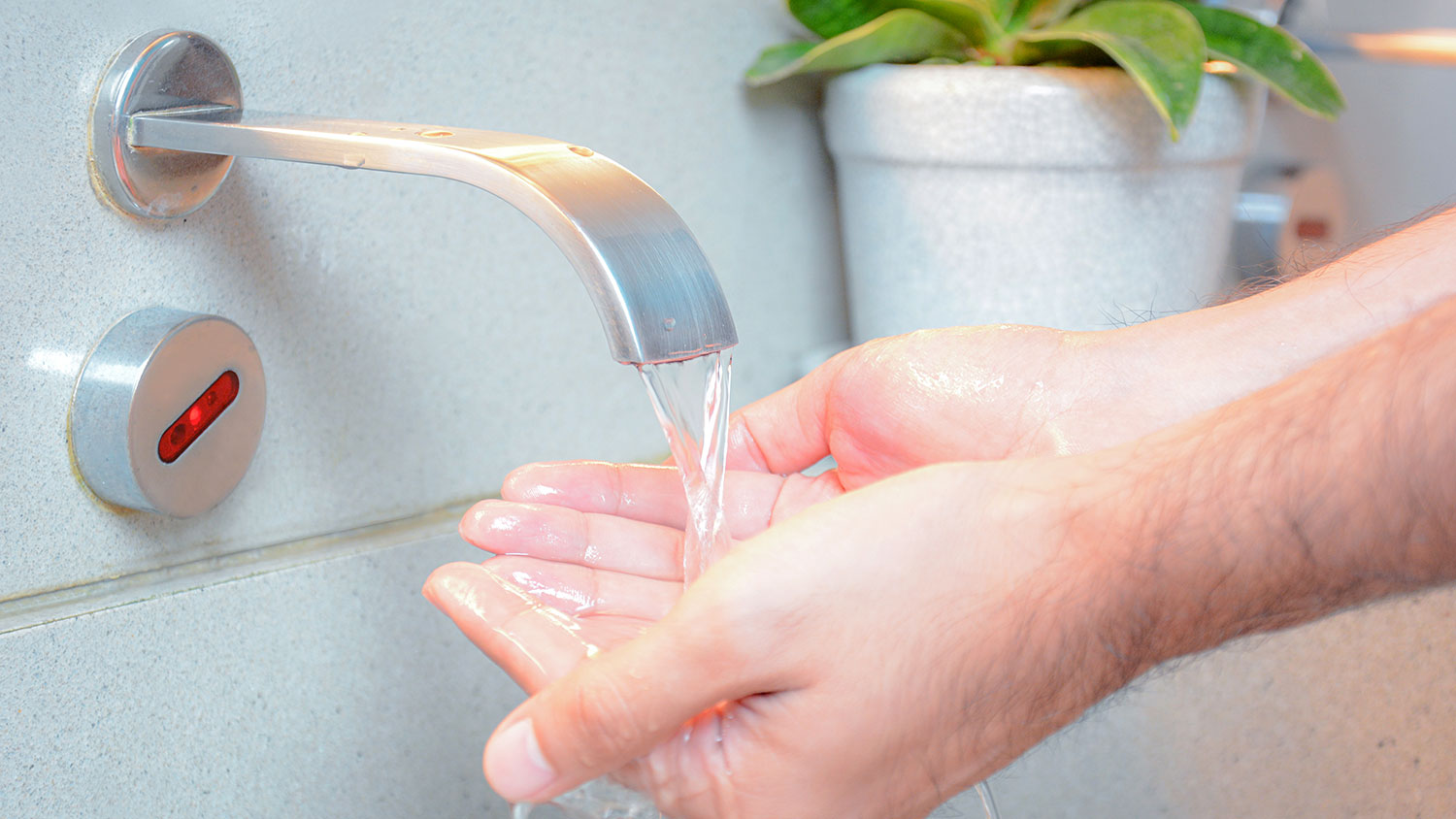What Is a Smart Kitchen Faucet and How Does It Work?
Bring on the fancy faucet vibes


Smart faucets are automatic, touchless faucets with electronic sensors.
Some faucets turn on and off with voice commands.
Consider the faucet’s power source and sensor accuracy.
Smart faucets conserve water and keep germs from spreading.
The average smart faucet cost is between $300 and $400.
Picture this: You’re making chocolate chip cookies in your kitchen. Suddenly, the phone rings and you need to wash your dough-covered hands. But, you don’t want to get your faucet caked in cookie goo. This is where a smart faucet comes in. But what is a smart kitchen faucet, and how does it work?
Smart faucets are all the rage, and for good reason. With the mere swipe of your hand or even the sound of your voice, you can get the water flowing or turn it off. If you’re considering installing smart faucets in your home, here’s what you need to know first.
What Are Smart Kitchen Faucets?
Smart faucets are automatic faucets with electronic sensors. These sensors turn the flow of water on (and off) when they detect movement, so you don’t have to turn the faucet knob. Most include hands-free operation via touch or motion.
In addition, some are even voice-activated, allowing you to do things like fill up containers and adjust the water temperature without touching the faucet. Some smart faucets are battery-powered, while others connect to a power source under the sink.
How Do Smart Faucets Work?

Smart faucets rely on electronic sensors to work. The sensor may detect motion, such as the wave of a hand or a light tap, or your voice. When the sensor is activated, it turns on the flow of water. Often, the faucets use a timer to know when to shut off the flow of water.
The faucets have varying degrees of intelligence. Some simply turn on and off without you having to turn a handle. Others connect to an app and can provide you with an up-to-the-minute history of your faucet's health. They'll let you know if there's a leak or allow you to turn the faucet on from a distance, such as when you're away from home and are concerned that the pipes may freeze.
Smart Faucet Features to Consider

Not all smart faucets are created equal. Here are the main features to consider to select the best possible faucet for your needs.
Motion Sensor Accuracy
The sensor on your smart faucet should start immediately when you trigger it. You definitely don’t want to have to wave your hand around multiple times just to get the water flowing. Choosing a smart faucet with multiple sensors is a good idea, as this helps increase accuracy.
Voice Commands
Some smart faucets turn on and off with voice commands, just like other smart home devices. Look for a faucet that integrates easily with virtual assistants.
Power Source
You have two choices when it comes to the power source: battery or electrical outlet. To help save money and time, either get rechargeable batteries or choose a faucet that plugs into an outlet (as long as you have access to power under the sink, that is).
Style and Finish
Smart faucets come in various finishes and styles, just like traditional faucets do. Whether you opt for stainless steel, chrome, or brushed nickel, just make sure to pick a model that fits in with your decor.
Pros and Cons of Smart Faucets
| Pros | Cons |
|---|---|
| Hygienic | Cost |
| Conserves water | Needs power |
| Convenient | More parts to break |
| Adds style |
You probably use your kitchen and bathroom sinks multiple times a day, so why not make washing dishes and hands that much easier? There are several reasons to consider a touchless faucet.
Pros of a Smart Faucet
Your hands get dirty when you're prepping food, whether you're baking a cake or working with raw meat. Since many smart faucets are motion or voice-activated, you don't have to touch a handle with your hands, which reduces the risk of spreading bacteria to the faucet and makes your kitchen more hygienic.
The "no touch" feature of smart faucets is also pretty convenient, making it easy for you to turn the sink on even when your hands are sticky or covered in sauce. Another benefit of a smart faucet is that it can help you use less water. Most faucets are low-flow and can be programmed to only run for a short time.
Finally, smart faucets are just plain sleek, and you have several attractive models to choose from.
Cons of a Smart Faucet
Smart faucets do have their drawbacks, the main one being that they can be more prone to breaking than standard faucets, since there are more components required for their operation. The faucets also rely on an external power source. If the batteries die or your home loses power, you may not be able to use the faucet until power comes back.
Smart faucets are more expensive than traditional faucets. If your budget is tight, you may want to go with a regular faucet.
Can You Install a Smart Faucet Yourself?
If you're a bit handy, you may consider tackling smart faucet installation on your own. However, keep in mind that smart faucets have more parts than standard faucets, so installation may be more challenging than usual.
Often, your best bet is to hire a local licensed plumber to get the job done. Depending on your location, local codes may require you to use a plumber. Talk to a local faucet installer to learn more about what's involved and what they recommend doing.
What Is the Average Cost of Smart Faucets?
Smart faucets cost between $300 and $400 for the unit, which is a bit more than a traditional faucet. Assuming you don’t need any upgrades (like new plumbing), regular kitchen faucet installation costs from $260 to $480, all in.
DIY-savvy homeowners can install a regular faucet themselves. The same isn’t true for smart faucets. Since smart faucets always require professional installation, you’ll have to factor in labor costs. Pros often charge $45 to $200 per hour in labor fees for this type of job.
Justine Harrington contributed to this piece.





- Bathroom Remodeling
- Kitchen Remodeling
- Shower Installation
- Stair Installers
- Bathtub Installation
- Shower Door Installers
- Kitchen Design
- Bathroom Design Companies
- Storm Shelter Builders
- Pre-Made Cabinets
- Kitchen Refacing
- Bathtub Replacement
- Ceiling Tile Installation
- Suspended Ceiling Companies
- Residential Designers
- Stair Builders
- Remodel Designers
- Shower Enclosures
- Home Renovations
- Kitchen Renovations
- Garage Remodeling
- Grab Bar Installation
- Walk-In Tub Installers
- Tub to Shower Conversion
- Balcony Contractors
- 14 Types of Kitchen Faucets and How to Choose One
- Bathroom Faucet Sizes: Are They All the Same?
- Pros and Cons of Wall-Mounted Faucets
- 7 Different Types of Bathroom Faucets
- 5 Benefits of Adding a Touchless Faucet to Your Home
- Waterfall Faucet vs. Regular Faucet: What Is The Best Option?
- Get To Know the Parts of a Sink Faucet
- How Long Do Bathroom Faucets Last?
- How to Protect Outdoor Faucets From Freezing Temperatures
- The 7 Types of Outdoor Faucets: Choose the Best Fit for Your Home’s Yard or Washing Needs










